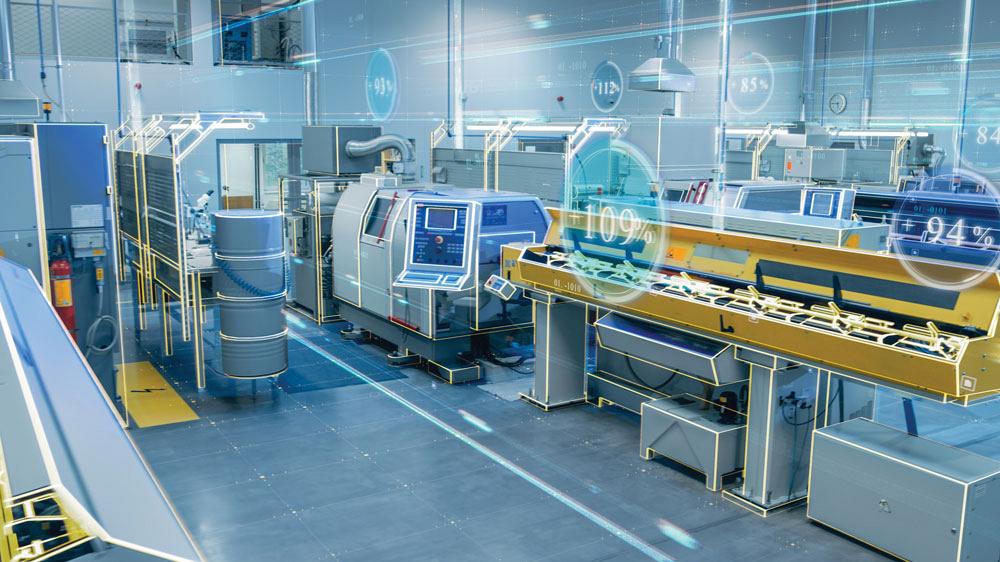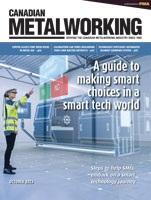chief commercial officer
- FMA
- The Fabricator
- FABTECH
- Canadian Metalworking
A guide to making smart choices in a smart tech world
Steps to help SMEs embark on a smart technology journey
- By Graham Immerman
- November 22, 2023
- Article
- Automation and Software

MachineMetrics’ analysis has shown that machines often operate at just about 24 per cent of their full capacity. These revelations have the potential to redefine business strategies. gorodenkoff/iStock/Getty Images Plus
Today’s manufacturers are under an incredible amount of pressure: fluctuating demand is driving a need to produce at higher capacity. The skilled worker shortage is driving an ever-greater need for efficiency and employee satisfaction. Heightened competition is driving the need to deliver high-quality products on lower margins.
Supply chain restructuring has been accelerated by the COVID-19 pandemic as the effects of a weakened supply chain are visible to all. Many companies are looking at restructuring their supply chains, trying to support rising demand with a balance of resilience, efficiency, and reduced costs. Is reshoring the answer?
Many companies think so. Heartland Forward’s February survey showed that 70 per cent of companies queried were likely or extremely likely to reshore in the coming years, with the top vertical most adept to do so being advanced manufacturing.
But with reshoring being a potential solution comes additional pressure on manufacturers to deliver products in record time, while continuing to cut costs, hire skilled labor, and increase equipment efficiency. There are simply not enough skilled workers; the current workforce is aging out and critical tribal knowledge is leaving with them.
There has never been a more important time to reduce the burden of non-essential manual tasks and decision-making, and the good news is that the technology exists to enable manufacturers to do so!
The problem is there are a lot of them. With the influx of smart technology offerings, from enterprise resource planning (ERP) systems and manufacturing execution systems (MES) to predictive maintenance tools all promising revolutionary change, how does a business discern the right starting point?
For many companies, the immense choices available become a barrier rather than a boon. Decision-making paralysis, amplified by inadequate data and a lack of visibility into the entire operational landscape, stunts their technological journey.
And the timing couldn’t be worse: supply chain restructuring has been accelerated by the COVID-19 pandemic as the effects of a weakened supply chain are visible to all. Many companies are looking at restructuring their supply chains, trying to support rising demand with a balance of resilience, efficiency, and reduced costs.
For smaller to mid-sized businesses, immediate introspection has become paramount. These enterprises must honestly assess their current state and articulate their future aspirations. By doing so, they can preemptively address potential challenges.
The Launchpad: 5 Areas for Initial Assessment
1. Identifying Pain Points. Before diving into technological options, it's essential for a business to identify and quantify its problem areas. This requires rigorous data collection, perhaps even casting a wide net over the entire facility to expose previously unnoticed bottlenecks. Pinpointing these areas facilitates a structured approach, allowing businesses to address issues sequentially, based on their impact.

While technology and data play crucial roles, the human element remains paramount. It's essential for businesses to ensure that the data and insights derived are communicated effectively across the organization. gorodenkoff/iStock/Getty Images Plus
2. Assessing Readiness. A transformative journey requires a company to understand its starting point. Self-awareness and acknowledging existing business issues paves the way for aligning technology with actual needs.
3. Aligning Stakeholders. In today's dynamic business landscape, maintaining the status quo is a myth. Engaging internal stakeholders and achieving alignment on growth and vision is vital. Any technological implementation will falter without internal buy-in. It's pivotal that all players, from leadership to the shop floor, understand and commit to the shifts necessary for achieving shared objectives.
4. Examining IT Infrastructure. At the core of any technological transition lies a robust IT infrastructure. Workshops must ensure uninterrupted and consistent internet connectivity. In today's hyper-connected age, it may seem inconceivable for businesses to grapple with connectivity issues, but it's a more common predicament than most realize. When delving into smart technology, seemingly trivial factors like the placement of machine networks relative to power lines can profoundly impact functionality.
5. Sharing Knowledge. Once upon a time, manufacturing thrived on closely guarded tribal knowledge. Modern businesses, however, are recognizing the value of democratizing information. As advanced technology permeates workshops, reliance on individual technology champions has grown, yet there's a palpable dearth of such experts.
Embarking on the Smart Tech Journey
In the vast sea of smart technologies, smaller enterprises often grapple with where to initiate and how to harness their full potential. While it's tempting to perceive new tech as a panacea, the reality is more nuanced. Integrating technology should be solution-oriented, addressing specific issues rather than attempting a comprehensive overhaul—an approach that can prove overwhelming.
Historically, manufacturing technology was dominated by monolithic systems that, despite their broad scope, led to disconnected operations. Such systems demanded extensive customization, prolonged time investments, and exhaustive manual data entry. With key personnel changes, companies found themselves stranded with unsupported systems.
Enter the new era of technology—agile, specialized, and integrable. These systems cater to specific manufacturing challenges with bespoke workflows, ensuring seamless data access and connectivity. Whether it's production, maintenance, quality, or operations, today's digital ecosystem employs software as a service (SaaS) technologies to elevate user experiences, minimizing manual interventions.
In essence, businesses no longer need to reinvent the wheel. The interconnectedness of contemporary technological ecosystems underscores the importance of holistic investments. Mere possession of cutting-edge technology isn't sufficient; understanding its short-term and long-term benefits is crucial.
Investing traditionally entailed augmenting equipment and manpower. But with the evolution of smart technology and software, the direction of investments is shifting. Businesses need not just adopt, but actively engage with new technology, establishing robust evaluation parameters. Quick victories with technology can catalyze momentum and ensure its sustained adoption.
People at the Forefront
As many businesses know firsthand, manufacturing is suffering from an ever-growing skills gap. There are simply not enough skilled workers to support demand for product.
As a fresh wave of professionals enters the manufacturing domain, it's crucial to recognize the generational shift in technological interactions. Younger workforce members, digital natives, interact differently with technology. Their intrinsic familiarity with digital tools means they expect, even demand, more intuitive and interconnected systems in their workplace.
Empowering these individuals is not merely about providing them with the latest gadgets or software; it's about creating an environment where innovation is encouraged and new ideas are welcomed. Integrating them into decision-making processes, fostering cross-functional teams, and promoting a culture of continuous learning are pivotal. Democratizing data access across organizational hierarchies further fosters a holistic embrace of new tools.
When technology and people harmonize, the results can be transformative. A workforce that feels included in the digital transition becomes its most significant advocate, driving efficiency and innovation from within.
Bridging Systemic Gaps
A salient challenge businesses face is the discord between their technology and overarching corporate objectives. Ensuring that new technological tools align with broader corporate goals is essential for coherent growth. The integration of various systems like ERP, machine data, and analytics equips managers with real-time insights, facilitating informed decision-making.
However, in the vast manufacturing arena, smaller entities often erroneously perceive their larger counterparts as technologically superior. The truth often belies this perception. Numerous large-scale entities struggle with fragmented systems, adding layers upon layers in hopes of finding the right fit. The end game? Seamless digital operations. And the race to this pinnacle is more about strategic decisions than speed.
The crux lies in bridging the gap between the central planning systems and the on-ground manufacturing realities. Earlier attempts, like MES, aimed to be this bridge. In the late 1980s, MES was born out of necessity due to ERP’s inability to capture shop floor transactions in real time. While MES was a significant step forward for manufacturers, its capabilities were designed for the technology available at the time. However, its top-down, process-driven approach often faltered. The solution? Integrable software and equipment that offers accurate, real-time insights.
The Bottom Line
When MachineMetrics embarks on a new customer, data often unveils startling truths. For instance, the company’s analysis has shown that machines often operate at just about 24 per cent of their full capacity. These revelations have the potential to redefine business strategies. Real-time data offers unprecedented insights, sometimes prompting a paradigm shift in investment strategies. For businesses, it's not just about procuring new assets; it's about understanding underlying issues and addressing them holistically.
Moreover, it's about realizing that the power of data isn't just in its collection but in its interpretation. Investing in analytics tools and expertise can turn raw data into actionable insights, driving strategic decisions that can unlock previously untapped potential. The road ahead mandates a comprehensive view, transcending singular equipment-based perspectives.
Furthermore, while technology and data play crucial roles, the human element remains paramount. It's essential for businesses to ensure that the data and insights derived are communicated effectively across the organization. When all levels of a company, from leadership to the shop floor, understand and act upon these insights, a true transformation can occur.
That said, a well-executed strategy based on real-time data and insights doesn't just change the way a company operates—it has the potential to redefine its entire future trajectory. Commencing with a targeted approach, addressing pressing issues, and gradually scaling up and connecting everything is the optimal strategy for smaller enterprises. While resource constraints can be challenging, affordable vertical technologies offer hope. This will not only deliver immediate benefits but also pave the way for future integrations, ensuring the sustained relevance of smart technology.
Graham Immerman is chief commercial officer at MachineMetrics, 47 Pleasant St. Ste 2-S, Northampton, Mass. 01060, www.machinemetrics.com.
About the Author
Graham Immerman
47 Pleasant St. Ste 2-S
Northampton, MA 01060
subscribe now


Keep up to date with the latest news, events, and technology for all things metal from our pair of monthly magazines written specifically for Canadian manufacturers!
Start Your Free Subscription- Trending Articles
Sustainability Analyzer Tool helps users measure and reduce carbon footprint

GF Machining Solutions names managing director and head of market region North and Central Americas

Mitutoyo updates its end-user portal

Enhance surface finish with high-speed machining

Portable 3D scanners offer adjustable scanning distance, advanced volumetric accuracy

- Industry Events
Automate 2024
- May 6 - 9, 2024
- Chicago, IL
ANCA Open House
- May 7 - 8, 2024
- Wixom, MI
17th annual Joint Open House
- May 8 - 9, 2024
- Oakville and Mississauga, ON Canada
MME Saskatoon
- May 28, 2024
- Saskatoon, SK Canada
CME's Health & Safety Symposium for Manufacturers
- May 29, 2024
- Mississauga, ON Canada















